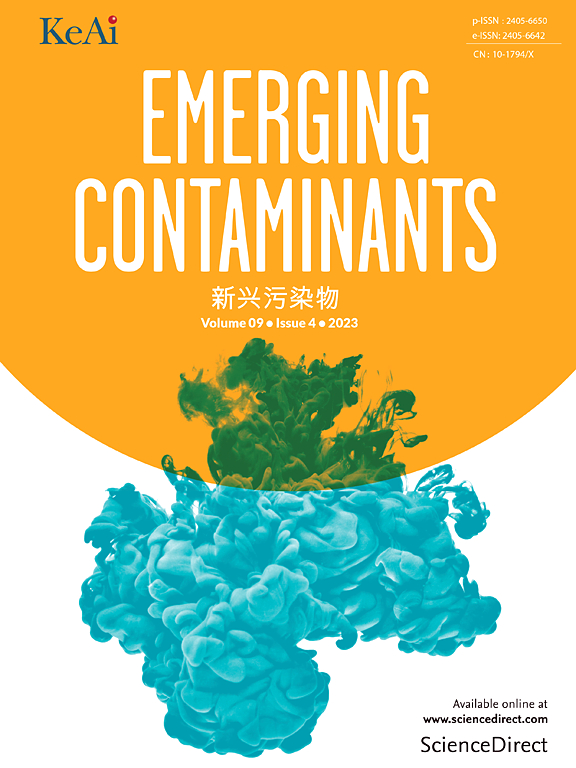Antibiotic resistance occurrence and ecological impact in landfill leachate: A review on compound effect of antibiotics and non-antibiotics
IF 6.9
2区 环境科学与生态学
Q1 ENVIRONMENTAL SCIENCES
引用次数: 0
Abstract
Landfilling remains one of the primary methods for managing municipal solid waste (MSW), processing approximately 350 million tons of waste annually. Among the various components of landfill waste, pharmaceuticals and personal care products (PPCPs), including both antibiotics and non-antibiotic compounds, pose significant environmental challenges. Landfill leachate is a highly complex medium, consisting of diverse contaminants such as non-antibiotic pharmaceuticals (average concentration ∼1.74 μg/L), antibiotics (average concentration ∼527 ng/L), heavy metals, dissolved organic matter, and micro/nano-plastics (concentration range 0.64–2.16 mg/L). This unique mixture can alter the native microbial community structure, profoundly impacting antibiotic resistance, potentially disrupting soil and groundwater ecosystems, and threatening ecological balance. Existing research has extensively investigated the composition, physicochemical properties, environmental behavior, and microbial community structure of landfill leachate, leading to significant advancements in the field. However, due to the complexity and large volume of landfill leachate, current risk assessment approaches predominantly rely on conventional pollutant indicators, and most treatment strategies are designed for general contaminants. There is a lack of systematic descriptions that integrate pollutants with their direct impacts on microbial communities. This review focuses on the current pollution status, spatiotemporal trends, interactions, and migration risks of antibiotics and non-antibiotic pollutants in landfill leachate. In particular, we explore the in situ emergence of antibiotic resistance in landfill leachate (rather than the horizontal transfer of antibiotic resistance genes) and examine the influence of various leachate components on antibiotic resistance. By emphasizing the importance of understanding the combined effects of antibiotics and non-antibiotic pollutants in landfill environments, this review highlights the necessity of long-term ecological risk assessments for antibiotic-induced resistance as an emerging contaminant.

垃圾渗滤液中抗生素耐药性的发生及生态影响:抗生素与非抗生素复合效应研究进展
填埋仍然是管理城市固体废物(MSW)的主要方法之一,每年处理约3.5亿吨废物。在填埋垃圾的各种成分中,药品和个人护理产品(PPCPs),包括抗生素和非抗生素化合物,构成了重大的环境挑战。垃圾渗滤液是一种高度复杂的介质,由非抗生素药物(平均浓度~ 1.74 μg/L)、抗生素(平均浓度~ 527 ng/L)、重金属、溶解有机物、微/纳米塑料(浓度范围0.64 ~ 2.16 mg/L)等多种污染物组成。这种独特的混合物可以改变本地微生物群落结构,深刻影响抗生素耐药性,潜在地破坏土壤和地下水生态系统,并威胁生态平衡。现有研究对垃圾渗滤液的组成、理化性质、环境行为和微生物群落结构进行了广泛的研究,取得了重大进展。然而,由于垃圾渗滤液的复杂性和体积大,目前的风险评估方法主要依赖于传统的污染物指标,大多数处理策略都是针对一般污染物设计的。缺乏将污染物与其对微生物群落的直接影响结合起来的系统描述。本文综述了垃圾渗滤液中抗生素和非抗生素污染物的污染现状、时空趋势、相互作用及其迁移风险。特别是,我们探讨了垃圾渗滤液中抗生素耐药性的原位出现(而不是抗生素耐药性基因的水平转移),并检查了各种渗滤液成分对抗生素耐药性的影响。通过强调了解抗生素和非抗生素污染物在垃圾填埋场环境中的综合影响的重要性,本综述强调了抗生素引起的耐药性作为一种新兴污染物进行长期生态风险评估的必要性。
本文章由计算机程序翻译,如有差异,请以英文原文为准。
求助全文
约1分钟内获得全文
求助全文
来源期刊

Emerging Contaminants
Medicine-Public Health, Environmental and Occupational Health
CiteScore
10.00
自引率
6.70%
发文量
35
审稿时长
44 days
期刊介绍:
Emerging Contaminants is an outlet for world-leading research addressing problems associated with environmental contamination caused by emerging contaminants and their solutions. Emerging contaminants are defined as chemicals that are not currently (or have been only recently) regulated and about which there exist concerns regarding their impact on human or ecological health. Examples of emerging contaminants include disinfection by-products, pharmaceutical and personal care products, persistent organic chemicals, and mercury etc. as well as their degradation products. We encourage papers addressing science that facilitates greater understanding of the nature, extent, and impacts of the presence of emerging contaminants in the environment; technology that exploits original principles to reduce and control their environmental presence; as well as the development, implementation and efficacy of national and international policies to protect human health and the environment from emerging contaminants.
 求助内容:
求助内容: 应助结果提醒方式:
应助结果提醒方式:


